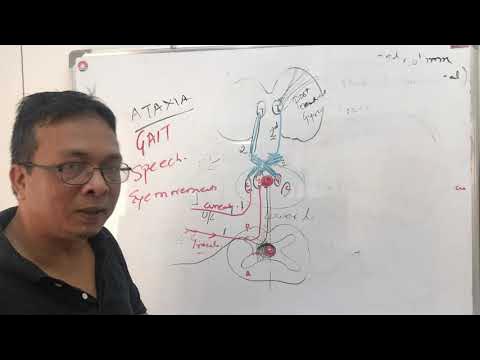Sensory Pathways MADE EASY!!
Summary
TLDRThis educational video script delves into the complex but crucial dorsal column medial lemniscus pathway, responsible for conveying fine touch, two-point discrimination, and proprioception to our sensory cortex. It explains the three-neuron chain of this ascending sensory pathway, contrasting it with the spinothalamic pain and temperature pathway. The script highlights the importance of understanding these pathways for diagnosing spinal cord injuries, emphasizing the differences in neural transmission and the implications for sensation below the level of injury.
Takeaways
- 🧠 The dorsal column medial lemniscus pathway is crucial for our ability to sense fine touch, two-point discrimination, and proprioception at the sensory cortex.
- 🌐 This pathway is an ascending sensory pathway, meaning it carries sensory information up the spinal cord towards the brain.
- 🔁 All ascending sensory pathways to the brain involve a three-neuron chain, starting with a sensory neuron that detects the stimulus.
- 📍 The somatosensory cortex, located in the postcentral gyrus behind the central sulcus, is where sensory information is processed.
- 🔄 The first neuron in the pathway synapses with the second neuron in the spinal cord, and the second neuron decussates, or crosses over, to the opposite side of the body.
- 🚀 The second neuron then ascends to the thalamus, where it synapses with the third neuron, which carries the information to the somatosensory cortex.
- 🌡️ The pain pathway is different from the dorsal column medial lemniscus pathway; it involves the spinothalamic tract and synapses at the level of the spinal cord before decussating.
- ⏫ The pain and temperature pathway bypasses the brainstem and goes directly to the thalamus, unlike the fine touch pathway which synapses in the medulla before reaching the thalamus.
- 🤕 In cases of spinal cord injury, the type of sensation affected can help determine the location and extent of the injury, as different pathways are affected differently.
- 🧩 The somatosensory cortex has a topographical map of the body, which is important for localized sensory perception.
- 🔍 Testing for spinal injury often involves stimulating different sensory pathways to assess which sensations are affected and to identify the side and level of injury.
Q & A
What is the dorsal column medial lemniscus pathway responsible for?
-The dorsal column medial lemniscus pathway is responsible for the sensation of fine touch, two-point discrimination, and proprioception, which is the awareness of one's body position in space.
How many neurons are involved in ascending sensory pathways to the brain?
-All ascending sensory pathways to the brain involve a three-neuron chain.
Where is the somatosensory cortex located in the brain?
-The somatosensory cortex is located in the postcentral gyrus, just behind the central sulcus in the brain.
What is the difference between the dorsal column medial lemniscus pathway and the pain pathway in terms of how they ascend the spinal cord?
-The dorsal column medial lemniscus pathway ascends on the same side of the spinal cord where it enters, synapses at the medulla, and then crosses to the opposite side. The pain pathway, however, crosses over to the opposite side immediately upon entering the spinal cord and ascends contralaterally without synapsing at the medulla.
What is the term used for the crossing of neurons in the spinal cord?
-The term used for the crossing of neurons in the spinal cord is decussation.
What is the role of the thalamus in sensory pathways?
-The thalamus acts as a relay station for all sensory information before it reaches the cortex. It is often referred to as the gateway to the cortex.
How does the body's topographical map on the somatosensory cortex relate to the sensations we feel?
-The topographical map on the somatosensory cortex represents different parts of the body, indicating which areas of the body are associated with specific sensory inputs.
What is the name of the pathway responsible for pain and temperature sensations?
-The pathway responsible for pain and temperature sensations is called the spinothalamic pathway.
Why is it important to understand the difference between the dorsal column medial lemniscus pathway and the pain pathway in terms of spinal cord injuries?
-Understanding the difference is important because it helps in diagnosing spinal cord injuries, as damage to one side of the spinal cord can affect different sensations on the contralateral side below the level of injury.
How can medical professionals test for spinal cord injuries in the context of the different sensory pathways?
-Medical professionals can test for spinal cord injuries by stimulating different sensory pathways, such as using fine touch or temperature stimuli, to determine if the patient can feel sensations on both sides of the body below the level of injury.
What is the significance of the ipsilateral and contralateral sides in relation to spinal cord injuries?
-The significance lies in the fact that damage to one side of the spinal cord can result in the loss of pain and temperature sensation on the contralateral side below the level of injury, while fine touch may still be felt on that side but not on the ipsilateral side below the injury.
Outlines

Этот раздел доступен только подписчикам платных тарифов. Пожалуйста, перейдите на платный тариф для доступа.
Перейти на платный тарифMindmap

Этот раздел доступен только подписчикам платных тарифов. Пожалуйста, перейдите на платный тариф для доступа.
Перейти на платный тарифKeywords

Этот раздел доступен только подписчикам платных тарифов. Пожалуйста, перейдите на платный тариф для доступа.
Перейти на платный тарифHighlights

Этот раздел доступен только подписчикам платных тарифов. Пожалуйста, перейдите на платный тариф для доступа.
Перейти на платный тарифTranscripts

Этот раздел доступен только подписчикам платных тарифов. Пожалуйста, перейдите на платный тариф для доступа.
Перейти на платный тарифПосмотреть больше похожих видео

DCML(dorsal column medial lemniscal):Rhomberg's test,posterior cord syndrome,Friedrich's Ataxia

Sensation from the Body: Neuroanatomy Video Lab - Brain Dissections

Ascending and Descending Spinal Cord Tracts Made Easy

Spinal Cord Mnemonics (Memorable Neurology Lecture 8)

Parietal Lobe | Cerebral Cortex

As grandes vias aferentes e eferentes: Introdução e vias aferentes - Parte 1
5.0 / 5 (0 votes)
